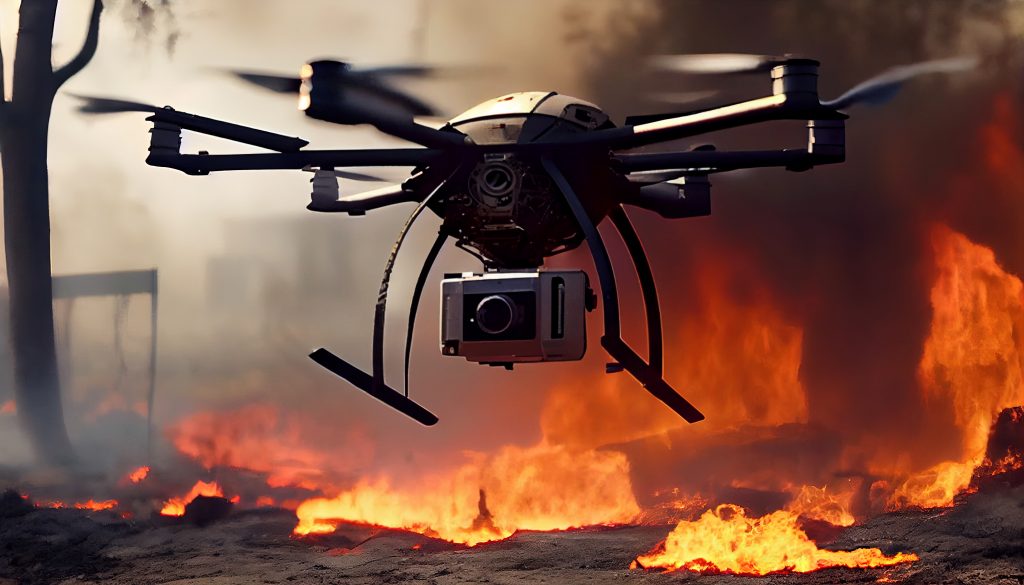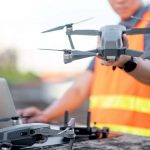When people hear the word “drone,“ they often think of uncrewed aircraft (UAVs). However, remotely operated underwater vehicles, also known as underwater ROVs or underwater drones, are the best choice for marine applications.
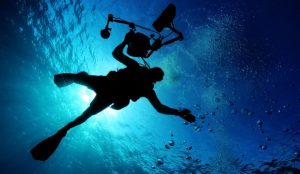
Like their airborne counterparts, underwater ROVs have recently surged in popularity.
In the same way that UAVs helped democratize the sky for thousands, industries and organizations worldwide whose job necessitates them to travel into aquatic environments are turning to underwater ROVs as cost-effective alternatives to reach those depths.
What are Underwater ROVs and Drones?

What is an ROV you asked?
As their names imply, underwater drones or remotely controlled vehicles (ROVs) are submersible, permanently attached, and highly agile drones meant to operate underwater.
Similar to airborne drones, underwater ROVs exist in numerous sizes. You can configure them to satisfy the needs of various nautical and underwater applications, and unlike their aerial counterparts meant for automated drone flights, most don’t require a drone parachute.
Due to their adaptability and low cost, many organizations and agencies that formerly relied on complex and expensive submarines and human divers to conduct underwater missions have almost entirely substituted them with underwater ROVs.
Due to their adaptability and low cost, many organizations and agencies that formerly relied on complex and expensive submarines and human divers to conduct underwater missions have almost entirely substituted them with underwater ROVs.
Including but not limited to the following asset tracking, structural assessments, public protection, search and rescue/recovery, defense and intelligence, academics, and ecological conservation.
A Brief History of Underwater Drones
The earliest versions of underwater drones date back to the 1950s, and their design allowed them to carry out duties for the Navy and research institutions.
The funds come from the budget allotted for the military. The Navy eventually gained control of drone technology and the best drone simulators, as happened with many other post-Cold War innovations.
During the 1960s, technology kept getting better. This made it possible for an underwater drone to recover a nuclear bomb. The retrieval took place off the coast of Spain, and no one knew about it for a long time.
Drones for commercial use started using them seriously in the 1970s. They even helped a stranded submarine’s crew in the 70s. Drives became more popular because they worked well and could do things humans couldn’t.
The 1980s are the defining decade that first introduced the world to underwater drones.
Using a novel remotely operated vehicle (ROV) was pivotal to Robert Ballard’s discovery of the Titanic. The United States Navy played a role in developing this apparatus, and this updated version facilitated the finding of the Titanic and Bismarck wrecks.
The 1990s saw the beginning of drones used for a wider variety of tasks.
Human divers no longer need to disarm mines, as newer drones can now perform this and more. In addition, there were upgrades to the deployment methods and the battery life. As a result, a wider variety of businesses began using drones.
The 2000s witnessed a tremendous increase in waterproof camera drones. This was the result of advancements in lithium-ion battery technology. Likewise, legislation also changes with examples like drone laws in Virginia and drone laws in Washington.
As this energy storage technology evolved, so did the development of drones. In the past, deploying a drone required a massive tether and a whole research vessel. In the twenty-first century, launching them from smaller ships and remote ID for drones became conceivable.
Since then, the use of drones has continued to increase, and the way they operate has also continued to improve.
How Underwater Drones Work?
Modern deep-sea drones function similarly to small submarines without a crew. These undersea drones are difficult to communicate with via radio. They can operate autonomously through inbuilt sensors. Another option is an extended cable directly linking the ship and drone.
Controlling buoyancy keeps an underwater drone from sinking. As with other underwater vehicles, they possess crush depths and are programmable to operate in a wide range of conditions. Their motors propel water, allowing the drone to move autonomously in response to commands.
Most underwater drones have a connection from their control unit to communicate with the operator on the ground. In real-time, users can regulate the drone’s tilt, height, and alignment in this control room. Cameras serve the drone’s eyes, allowing controllers to steer it to its intended destination.
5 Interesting Facts About Underwater Drones
1. UUV Communications
ROVs (remotely operated vehicles) and UUVs (uncrewed underwater vehicles) communication is a major part of drone logistics. Manufacturers typically use optical or electrical cables or wireless technologies (remotely operated vehicles).
Electromagnetic signals like RF (radio-frequency) lose their strength quickly in water. Without a very powerful transmitter, it is impossible to communicate over long distances. Because this is not feasible for UUVs, wireless underwater communications rely on other technologies, such as the following:
-
Acoustic Transmissions
Acoustic waves travel through water very well, which is the most common way underwater vehicles communicate wirelessly.
-
Optical Marine Communications
Underwater optical communication systems have also been designed with laser or light-emitting diodes (LEDs) commonly used for LOS (line-of-sight) transmission. Compared to acoustic communication, the data rate and latency of optical communication are substantially higher, but their range is much smaller.
-
ROV Transmissions
Tethered links to the surface are typically used for communication for remotely operated vehicles (ROVs). Some underwater robots will travel to the surface independently, with a recovery system or through a tether drone management platform if they can’t communicate with the operator. ROVs without tethers are currently under-development.
-
Magnetic Induction
Underwater magnetic induction communication employs magnetic coils to transmit signals. Even though this method of communication has almost no delay, it has a short range.
2. Tailored to Different Users
Since water drones are easier to get, more people are using them. Consequently, they are diversifying into a wide range of ocean-related sectors.
Generally, users of ROVs fall into two separate categories, namely:
-
The Professional
An example of a suitable professional underwater drone for the DTG3 Navigator ROV and its larger sibling, the REVOLUTION ROV, which is exploited for ocean floor research or investigations at depths that divers are frequently unable to access. For example, a working-class underwater drone can serve as a risk-free substitute for divers in various contexts, including offshore surveillance projects, military, emergency response operations, and deep archaeological digs.
-
The Enthusiast
People are becoming more interested in the ocean, and equipment that used to be hard to get or too expensive has become more accessible. This has made underwater drones a popular hobby for countless people. There is a submarine camera drone for everyone, whether you are a serious photographer or videographer or want to see what’s down there. ROV DTG3 Expert and ROV DTG3 Smart provide an all-inclusive kit for submarine observation for amateurs.
3. The Association of Unmanned Vehicle Systems International
Association for Unmanned Vehicle Systems International’s (AUVSI) event presented the industry’s biggest trade fair, titled XPONENTIAL 2016, in 2016. Over 8,000 robotics and unmanned systems innovators and professionals convened to explore the most recent developments in the crewless systems market, mainly remotely operated uncrewed underwater vessels.
In the realm of unmanned systems, there is a predominant focus on aerial vehicles. However, due to constant technological developments, underwater smart drones have been extensively employed across the history of crewless operations. They have been used in the hunt for the missing Malaysian aircraft, for ordinary ship repair, and for many other purposes.
Numerous businesses are progressively dependent on underwater drones, which have an ongoing influence on underwater operations. Luckily, operational intelligence (OI) technology can help keep drones safe and give data insights that have never been seen before below water. By integrating diverse data sources to provide increased situational awareness, the system protects the safety and efficiency of several operations.
4. The Different Classifications of ROVs
ROV systems fall into three fundamental categories:
-
Work Class
Work-class systems have massive frames (recorded in several yards/meters) with cross-functional manipulators, hydraulic propellants, and powerful tools enabling major submarine construction projects requiring heavy equipment transportation.
-
Observation Class
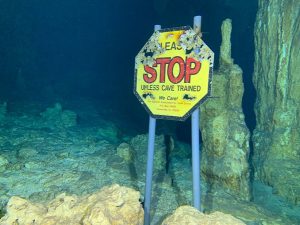
Observation-class ROVs are typically a “flying eye“ developed for modest use featuring propulsion technologies for transporting a camera and sensor kit to a location where it can produce a relevant image or collect data. The most recent observation-class ROVs allow this equipment to do more than observe.
-
Special Use
The term “special-use ROV systems“ refers to tethered, purpose-built underwater vehicles. A cable burial ROV system, which helped plow the sea floor and lay telecommunications wires, is an example of a vehicle built for a specific purpose.
5. It’s the Small Things That Count on Human/Drone Operations
Divers may be exposed to an elevated danger during concurrent ROV/diver operations for various reasons, including the possibility of tangling, physical contact between the drone and the diver, and other areas of interaction. Therefore, the safety of divers is of utmost importance.
So, a pre-job briefing covering all the people involved in the task is a crucial component of any industrial operation between divers and underwater drones. The ROV supervisor must brief the crew to ensure their safety and security after the client representative, vessel or facility operator, and supplier approve the proposed procedure.
Some Unique Uses of Underwater Drones
Due to their small size and ability to move in any direction, underwater drones provide marine and subsea industries, agencies, and organizations with risk-free and cost-effective means of remote asset evaluation, monitoring, and inspections. The following is a list of some instances of real-world applications for underwater ROVs:
-
Aquaculture
Underwater remotely operated vehicles (ROVs) serve aquaculture businesses through remote inspection of fish farms. In the past, fish farmers had to do this manually by diving. Now, an underwater fishing drone can help with this task.
-
Utility
Companies in the utility industry, such as those in the electricity and telecommunications sectors, can use underwater drones to inspect and keep tabs on their subsea and underwater infrastructure. Pipelines, power lines, and fiber optic data wires are all within the scope of observation for underwater drones.
-
Global Shipping
Shipyards and shipping businesses can save time and money by using a ROV underwater drone to conduct routine ship inspections from a safe distance. They can monitor shipyard operations, inspect vessels for damage, detect gas leaks and oil spills and provide damage evaluations.
-
Offshore Energy
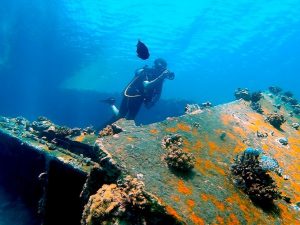
Remotely operated underwater vehicles (ROVs) provide offshore energy firms with a risk-free and economically viable means of performing in-depth industrial inspections from a distance. They can do servicing on platforms that are out at sea without putting engineers in danger.
-
Public Services
Drones designed to operate underwater are an excellent tool for government agencies and nonprofits responsible for the upkeep of public water infrastructure. They frequently conduct in-depth checks of the infrastructure and security of ports and waterways, and they can also monitor bridge abutments, piers, dams, and other underwater systems.
-
Defense And Safety
ROVs can scout, detect, identify, and destroy potentially hazardous undersea threats that may be present inside naval theaters of activities without putting human assets in peril. This is made possible by the remote-control nature of ROVs.
-
Academia
ROVs significantly reduce the entry barrier for students and educators in marine biology, nautical engineering, and other maritime professions, as they are considerably less expensive than prohibitively expensive submarines. Using an underwater ROV, educators can perform safe and efficient subaquatic excursions to unravel the wonders of the deep oceans.
-
Search/Rescue/Recovery
Underwater ROVs are well-suited to a wide variety of SAR and salvage activities due to their capacity to accommodate several add-ons (such as floating robotic arms and other search and recovery equipment). One distinct benefit is that they can collect and transport loads that would be impossible for human divers to handle. Before deploying human assets in circumstances requiring human divers, an ROV drone can assess potential environmental hazards.
-
Marine Conservation and Maintenance
Underwater remotely operated vehicles (ROVs) are helpful for aquatic conservation and biological preservation because of their tiny size and quiet operation. They make it easier to keep an eye on the oceans without disturbing the hundreds of thousands of marine species and many habitats.
Conclusion
Modern underwater drones serve a variety of roles, including that of rescuers and repairers. These devices find themselves the focus of diplomatic crises and submarine catastrophes. Since its inception nearly 70 years ago, the unassuming underwater drone with claw has proven its worth in every facet of ocean research and exploration.
As with other aspects of drone technology, underwater drones are here to stay and keep adding to what we know about the ocean. Absent underwater drones, the world’s oceans might be less researched and navigable than they are already.
Underwater drones may discover life in distant marine habitats. They are still one of the most fascinating and productive pieces of technology recently designed by humans.




